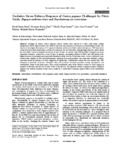Use este identificador para citar ou linkar para este item:
http://biblioteca.incaper.es.gov.br/digital/handle/item/1068Registro completo de metadados
| Campo DC | Valor | Idioma |
|---|---|---|
| dc.contributor.author | BUSS, D. S. | pt_BR |
| dc.contributor.author | DIAS, G. B. | pt_BR |
| dc.contributor.author | SANTOS, M. P. | pt_BR |
| dc.contributor.author | VENTURA, J. A. | pt_BR |
| dc.contributor.author | FERNANDES, P. M. B. | pt_BR |
| dc.contributor.other | David Shaun Buss, UFES; Germana Bueno Dias, UFES; Mirella Pupo Santos, UFES; Jose Aires Ventura, Incaper; Patricia Machado Bueno Fernandes, UFES. | pt_BR |
| dc.date.accessioned | 2015-12-16T10:48:00Z | - |
| dc.date.available | 2015-12-16T10:48:00Z | - |
| dc.date.created | 2011 | pt_BR |
| dc.date.issued | 2015-12-16 | pt_BR |
| dc.identifier.other | 9918 | pt_BR |
| dc.identifier.uri | http://biblioteca.incaper.es.gov.br/digital/handle/item/1068 | - |
| dc.description | Seedlings of papaya (Carica papaya), cultivar Golden, were exposed to a nitric oxide donor, sodium nitroprusside (SNP), Papaya meleira virus (PMeV) and yeast (Saccharomyces cerevisiae, as a model fungal elicitor). The aim was to investigate the response of C. papaya to infection and the role of nitric oxide in this process. SNP alone led to a short lived (6 h) burst of peroxidase activity and a relatively low level thereafter, although higher than the control, whilst the virus PMeV caused a sustained increase for at least 30 days. In contrast, both SNP and PMeV treatments increased superoxide dismutase activity for at least 30 days. In general, concomitant addition of PMeV and SNP produced the highest increases in peroxidase and superoxide dismutase activity over the 30 day time course. Levels of phenolics were elevated after addition of SNP and histochemistry confirmed increased peroxidase and superoxide dismutase activity, especially around the phloem cell walls, suggestive of lignification. Carbohydrate content was also elevated after SNP treatment, in particular saccharose. Treatment with yeast produced increased peroxidase activity and phenolic and carbohydrate content in the plant tissues. These results demonstrate some of the defences elicited in Carica papaya in response to infection, and the role of nitric oxide in this process. The apparent systemic acquired resistance displayed suggests that artificial initiation of this process might be a useful future technique against PMeV in the horticultural industry. | pt_BR |
| dc.language | en | pt_BR |
| dc.publisher | The Open Nitric Oxide Journal, v. 3, p. 55-64, 2011. | pt_BR |
| dc.subject | Mamão | pt_BR |
| dc.title | Oxidative stress defence response of Carica papaya challenged by nitric oxide, Papaya meleira virus and Saccharomyces cerevisiae | pt_BR |
| dc.type | -- | pt_BR |
| dc.ainfo.id | 9382 | pt_BR |
| dc.ainfo.lastupdate | 2015-12-16 | pt_BR |
| dc.ainfo.depositante | Merielem Frasson | pt_BR |
| dc.subject.nalthesaurus | Antioxidant | pt_BR |
| dc.subject.nalthesaurus | Carbohydrate | pt_BR |
| dc.subject.nalthesaurus | Carica papaya | pt_BR |
| dc.subject.nalthesaurus | Nitric oxide | pt_BR |
| dc.subject.nalthesaurus | Papaya meleira virus | pt_BR |
| dc.subject.nalthesaurus | Peroxidase | pt_BR |
| dc.subject.nalthesaurus | Superoxide dismutase | pt_BR |
| Aparece nas coleções: | Memória Técnica do Incaper  | |
Arquivos associados a este item:
| Arquivo | Descrição | Tamanho | Formato | |
|---|---|---|---|---|
| BRT-oxidativestressdefenceresponceofcaricapapaya-jventura.pdf | 3,43 MB | Adobe PDF |  Visualizar/Abrir |
Os itens no repositório estão protegidos por copyright, com todos os direitos reservados, salvo quando é indicado o contrário.
